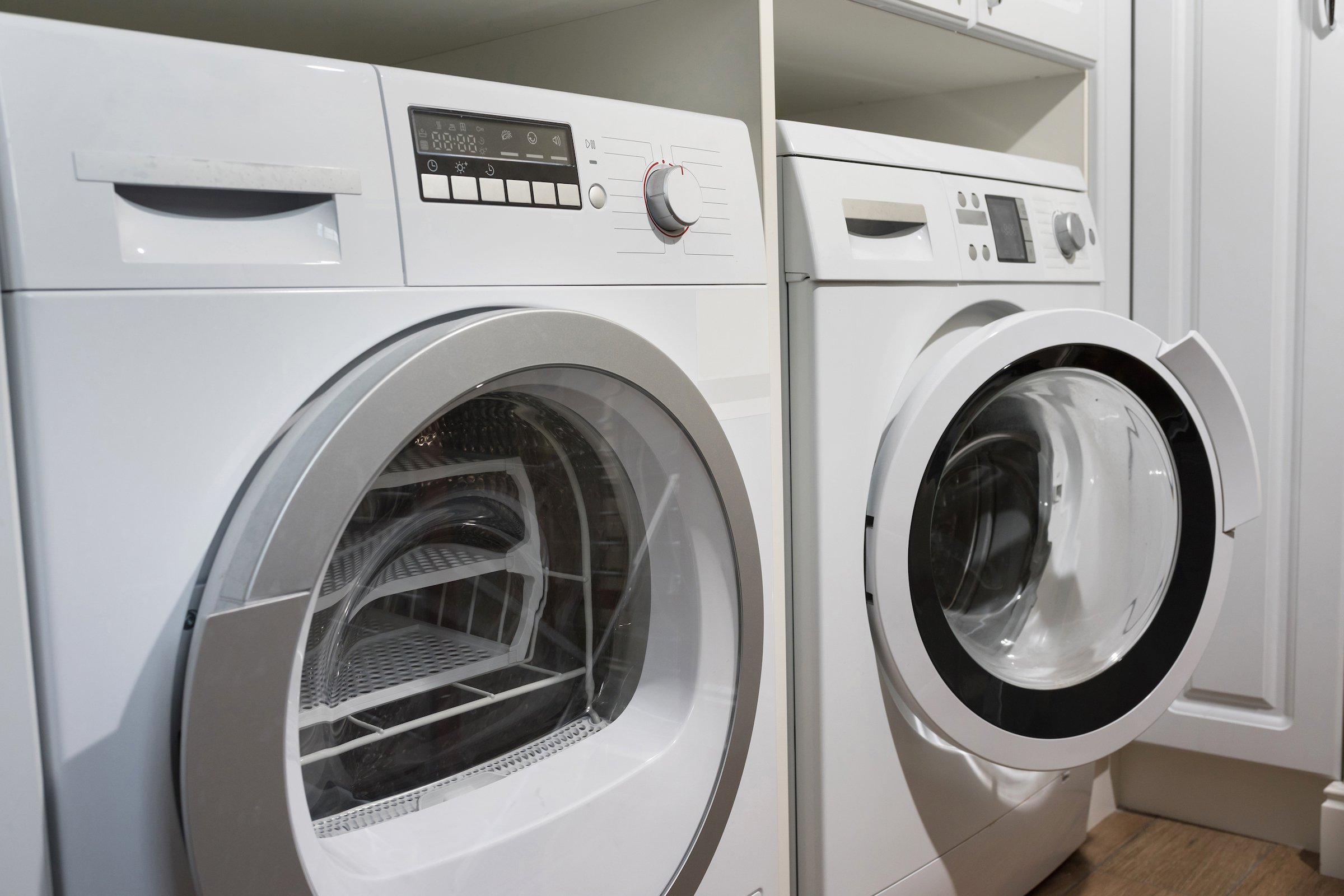If your dryer is making a grinding noise, there's a good chance that something is wrong. While older appliances may not run as quietly as newer machines, ignoring the sound could lead to significant problems and breakdowns.
Specific noises can be good indicators of where to look, so you’ll want to listen carefully to determine what type of sound your dryer is emitting. Squeaks, grinding, squealing, thumping, screeching, and rumbling are all indicative of unique faulty or failing parts.
Troubleshooting the issue yourself could save time and money, so we’ve put together a list of typical problems and solutions to help you decide the best course of action—repair the machine yourself or call in a professional.
If Your Dryer is Making Squeaking Noise, This Could be the Issue
A dryer can make a loud squeaking noise if a part called the idler pulley or tensioner is not functioning properly. The idler pulley puts tension on the drum belt to keep it from slipping while the dryer is spinning. Friction build-up can cause the pulley to wear out and is often responsible for a squeaking noise.
You’ll often notice the loud squeaking sound as soon as you turn the dryer on with a load of clothes. As the idler pulley rotates faster, it will likely get louder. You can inspect the idler pulley to see if it is the problem.
Dryer Part that Might be Faulty:
Check it out by unplugging the dryer and removing the front or lower access panel. The idler pulley and shaft are next to the drive motor. After removing the belt, manually turn the pulley. If it doesn't rotate smoothly or you see signs of wear or damage, you should replace the idler pulley and possibly the shaft.
How to Fix:
If you’ve determined that the idler pulley is a culprit, it’s time to call in reinforcements. An appliance technician will be able to safely and efficiently replace this part. Continued use could lead to a fire or major malfunction, so you should stop using the dryer until it is repaired.
Dryer Making a Grinding Noise? Here’s How to Troubleshoot

Like many dryer parts, the drum support bearing can wear out over time and make a grinding noise. It supports the rear of the dryer drum so it gets a lot of use with each load of laundry.
To troubleshoot this part, unplug the dryer, remove the front panel and belt. Try to turn the drum by hand. If the bearing is worn out, you'll notice it's hard to turn and will make a grinding sound. It's time to replace the bearing.
Dryer Part that Might Be Faulty:
If you’ve determined that the rear drum bearing needs to be replaced, you’ll need to check your owner’s manual for the proper parts. Replacement kits usually include a shaft, bearing, ground strap, and screws.
How to Fix:
- Disconnect electrical supply and shut off gas, if applicable.
- Access bearing by opening the cabinet and removing the drum.
- Remove one screw from the support bracket located on the back wall of the dryer cabinet. Pull the bearing away from the one side of the bracket and replace the screw. Don’t lose the small metal ball on the back of the nylon support as you’ll need it later.
- Take out the screw from the other side of the bracket and remove the other bearing (keep the metal ball on this side also.)
- Insert high-temperature grease (supplied with the kit) into the small hole in the cabinet between the two screws you just removed as well as the hole in the replacement support bearing.
- Remove the small metal ball from the bearing wall and replace it with a new support bearing. It will pop into place.
- Insert the replacement bearing into the support bracket (one side at a time) and screw into place.
- Attach the bracket and bearing to the dryer cabinet and fill it with high-temperature grease.
- Reinstall the drum and reassemble the cabinet.
If this project feels too complicated or beyond your skill level, contact Puls to provide fast, expert service for your dryer.
If Your Dryer is Making Squealing Noise, This Part Could be the Culprit
A long, thin drive belt helps the dryer drum spin. It wraps around the drum, tension pulley and drive motor. After years of use, the drive belt can fray or crack and cause a squealing noise when the dryer runs. Inspect the belt for signs of damage by unplugging the machine and removing the lower access panel. Contact a Puls’ qualified repair technician to replace the drive belt if it's worn.
A Dryer Making a Thump Noise Probably Has This Issue
A torn drum seal can produce a thumping noise as excess air enters the dryer drum. It's supposed to cushion the space between the drum and the front and rear bulkheads, but often wears out after many years of use. You may also notice rips or black marks on your clothing as they become stuck when the drum is turning.
The drum seal is made from a felt-like material and clothing can get caught in the exposed gap where the seal is torn or ripped. Your dryer may have more than one drum seal. You should replace them all at once.
Dryer Part that Might Be Faulty:
To determine if your drum seal(s) is causing the thumping noise, disconnect the power supply, open the dryer cabinet, and remove the drum. Inspect for signs of damage and replace if necessary.
How to Fix:
- Disconnect electrical and gas sources, if necessary.
- Open dryer cabinet, remove drum.
- Peel the felt seal from the dryer drum and remove any remnants with fine-grit sandpaper. Use liquid adhesive remover to clean the edge of the drum and dry thoroughly.
- Place a new seal around the drum and attach with adhesive underneath the seal and around the drum.
- Once dry, reinstall the drum and close the cabinet. This can be quite labor-intensive and may require a professional service technician.
Dryer Making a Screeching Noise? Do This.
The drum support rollers and shaft are located on the front and rear bulkheads. Over time, they can wear out and cause a screeching noise.
Access the rollers through the front panel after unplugging the dryer. Remove the rollers, and clean and lube them up. We recommend using 30-weight oil. Lubing up the drum support rollers will allow the drum to turn easily.
Dryer Parts that Might Be Faulty:
When you remove the drum support rollers, carefully examine them for signs of wear. If they look worn flat or broken, then it’s time to replace them.
How to Fix:
- Disconnect electricity and gas, if applicable.
- Lift the top panel, remove the lint screen and lint screen housing by removing the screws. Lift the top panel by using a putty knife to release the locking clips at the front of the dryer. Prop it up.
- Remove the front panel by disconnecting the door switch wire harness, and removing mounting screws. Pull the panel forward and lift out of the bottom hangers.
- Remove the drum—take a photo of the belt for easier reassembly. Pull the drive belt off the idler and motor pulley. Pull the drum out.
- Remove the drum support roller off the shaft by prying it with a screwdriver.
- Install the new roller by pushing it onto the shaft. Hold it in place with the triangular washer supplied.
- Reinstall the drum and thread the drive belt through the idler and motor pulleys as noted in the photo you took.
- Reinstall the front panel, reconnect the door wiring harness and reassemble the top panel with lint housing and screen.
- Plug in the dryer and turn the gas back on.
How to Prevent Your Dryer From Making Loud Noises
Preventative maintenance for your dryer will help keep it running at peak performance for years to come. Always clean the lint screen before each load to keep a strong airflow. Excess lint can lead to a blown thermostat or thermal fuse. Too much lint can also clog moving parts like the drum rollers and idler pulley which will lead to a noisy machine.
Clean the dryer duct once every year to increase efficiency and reduce a potential fire hazard. Even a partial blockage can restrict the airflow and increase dry times. Overloading your dryer will have the same effect on decreased airflow. The longer the dryer runs, the faster parts will wear out—leading to noise and breakdowns. Dryer drum rollers will flatten and break if you overload the appliance with too many clothes. This will add to the noise factor and ultimately expense of repair.
How Much Does it Cost to Call an Expert to Fix a Dryer that is Making Noise?
A noisy dryer can be evaluated in no time for a low service call fee of $89. Receive an on-the-spot, accurate quote. Move forward with the repair and we’ll waive the fee. Be prepared for anything, including a noisy dryer, by becoming a Puls+ member. Peace-of-mind Home Appliance Protection plans and Click & Fix plans are available for a low monthly fee and offer discounts, extended guarantees, member perks, and special offers. Safeguard your budget from unexpected expenses for all home services and you’ll never worry about unexpected costly repair bills again.
FAQ’s
- Is my noisy dryer worth repairing?
- In most instances, it will be most cost effective to repair your dryer instead of replace it. You may be able to correct the problem yourself, and even if you require a professional service call, it will still likely be worth the repair.
- Do all dryer noises require service?
- No, many stray objects fall out of pockets and cause loud noises. Always check for coins, screws, and other loose objects that could damage your machine. Also, always zip up jackets and hoodies to keep zipper pulls from clanking against the drum.
- Will overloading my dryer cause it to be noisy?
- Over time, continued overloading will reduce air flow, increase drying times, and overwork the rollers and other moving parts leading to a noisy dryer. It will definitely reduce the life-cycle of your appliance.
- Do I have to vacuum the dryer cabinet regularly?
- Yes, removing dust buildup inside the machine will keep the motor, rollers, and idler pulley moving unrestricted. This will keep those parts operating smoothly and add years to trouble-free drying.
- Can dryer sheets cause a dryer to become noisy?
- Yes, the sheets can be pulled into the air duct during the drying cycle and clog the blower wheel. Once it is obstructed, air flow is reduced and the dryer will make a loud humming noise. Using dryer lint balls will eliminate this problem and the need for dryer sheets.
If You Need Professional Support, Give Us a Call

If you're just not handy at repairing appliances or don't have the time to troubleshoot the issue, Puls can help. We've got a dedicated, experienced team of technicians on call to repair your machine, and even offer same day appointments.
For a limited time only, you can Save 5% when you book online with the code: APR5. An expert repair specialist will inspect, diagnose, and offer a solution to your problem. Appliance repairs are always quoted upfront with no hidden fees so you’ll know exactly what is needed to fix your machine.
All repairs are covered by our peace-of-mind 90-day guarantee so you can feel confident the job will be done right.
Don't ignore that noisy dryer another minute. Book a Puls online appointment at a time that works for you.





